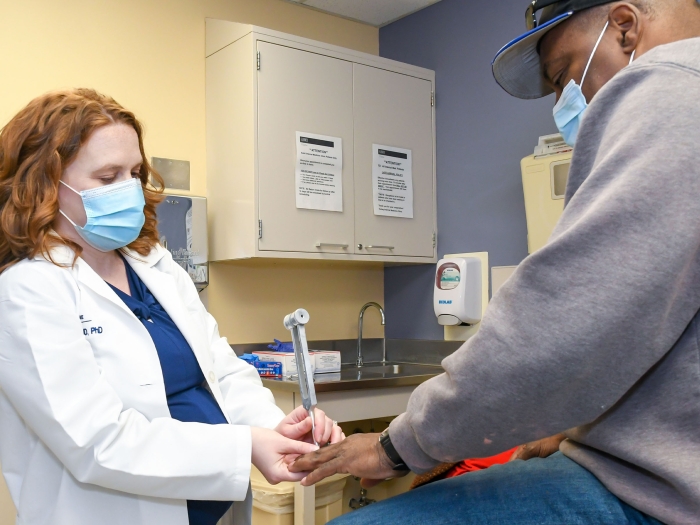Medication for diabetic eye disease is crucial, but it’s hard to tell in advance when and how often patients might need it. New research aims to provide insight.
2:15 PM
Author |

When vision problems arise, many patients with diabetic retinopathy rely on periodic injections of anti-vascular endothelial growth factor (anti-VEGF) medication.
MORE FROM THE LAB: Subscribe to our weekly newsletter
Delivered into the eye via syringe, the medications reduce abnormal blood vessel growth and swelling in the retina that can contribute to vision loss.
But the frequency and timing of anti-VEGF doses vary widely by individuals, and the reasons why remain a mystery to medical professionals.
"We have no predictive capability," says Anjali Shah, M.D., an assistant professor of ophthalmology at the University of Michigan. "If you have two patients that have the exact same eye findings, I couldn't tell you which one is going to need six injections, which one will need 12 injections — or if they'll do just fine with no injections at all."
That uncertainty has motivated Shah and her colleagues at U-M's Kellogg Eye Center to collect more detailed medical data from patients during their injection visits.
The goal: To analyze other aspects of their health that could help clinicians begin to predict when patients might expect to need the crucial treatments — and to determine what preventive tactics, if any, could help delay or reduce anti-VEGF injections, which can fluctuate in cost from as little as $50 to $2,000.
Because the drugs aren't administered until significant diabetic eye disease presents, implementing such a model could also benefit eye care providers.
"From a health system standpoint, you can better allocate resources to patients who are going to need them," Shah says. "A relatively small number of patients require a very large number of resources; we need to figure out who those people are and why they are in that group."
Finding insights in patient data
As director of the Comprehensive Diabetic Retinopathy Program at Kellogg, Shah knows the issue is a major concern for ophthalmologists. Diabetic retinopathy is the leading microvascular complication of diabetes — and it's the leading cause of blindness in working-age adults.
SEE ALSO: Diabetic Eye Issues a Growing Problem in Youth with the Disease
Shah and other experts also know that the risk factors for developing diabetic retinopathy include poor glycemic control (as measured by hemoglobin A1c levels) and high blood pressure.
Little is currently known, though, about whether those same risk factors impact the need for or frequency of treatment. Shah's analysis of the data suggests that health characteristics that put patients at risk for developing disease may not be the same as those that dictate the need for intensive treatment.
"We have no idea why some patients respond better than others and some need more intensive treatment," Shah says, noting that physicians and patients alike have different thresholds for initiating the medication.
Which is why Shah has been asking Kellogg patients to provide information about themselves. Her findings, which are displayed on a poster this week at the Association for Research in Vision and Ophthalmology conference in Honolulu, Hawaii, represent 12 months of data gleaned from 2,382 individuals that came to Kellogg for treatment.
The Comprehensive Diabetic Retinopathy Program already involves the collection of hemoglobin A1c and blood pressure values on all diabetic patients presenting to the retina clinic at Kellogg. That data, as well as responses to questions regarding history of kidney disease and duration of diabetes, were analyzed along with other information, such as BMI, already available in the electronic medical record.
"Since we collected the data, we looked at all of the information and whether we could find a relationship," Shah says.
Findings and next steps
Poised for further study, the early data offers some clues that could shed insight on why some people need the shots more often than others.
Among the diabetic patients in the analysis, the frequency of visits ranged from 1 to 27 times, Shah's data showed.
SEE ALSO: The Surprising Effect of Social Connections on Eye Health
Elevated blood pressure, both systolic and diastolic, was significantly associated with receiving at least one anti-VEGF treatment over a yearlong period, Shah says.
Compared to type 1 diabetes, patients with type 2 are more likely to receive injections — not only for a single injection but also more than once, the data showed.
One thing that didn't appear to correlate with the need for and frequency of anti-VEGF injections was hemoglobin A1c levels, a well-known risk factor for the development and progression of diabetic retinopathy.
Shah, who plans to submit a more detailed version of the study for journal publication, hopes the ongoing research will lead to real-life applications.
"I could better prognosticate for a patient sitting in my chair," Shah says. "I can say, 'Look, given this data, I can tell you're more likely to need six more injections in a year."

Explore a variety of health care news & stories by visiting the Health Lab home page for more articles.

Department of Communication at Michigan Medicine
Want top health & research news weekly? Sign up for Health Lab’s newsletters today!





